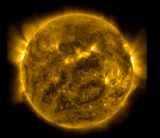NASA’s Interface Region Imaging Spectrograph, or IRIS, solar observatory separated from its Pegasus rocket and is in the proper orbit. This followed a successful launch by the Orbital Sciences Pegasus XL rocket from Vandenberg Air Force Base, Calif. It was the final Pegasus launch currently manifested by NASA. NASA’s Launch Services Program at the agency’s Kennedy Space Center in Florida managed the countdown and launch.
To read more about IRIS, visit https://www.nasa.gov/mission_pages/iris/index.html
This article is a great extension to the NASA Explorer Schools featured lesson, Geometry: Space Math Problems—Solar Storms. Access this lesson on the NES Virtual Campus.

 In the three years since it first provided images of the sun, NASA’s Solar Dynamics Observatory has had virtually unbroken coverage of the sun’s rise toward solar maximum, the peak of solar activity in its regular 11-year cycle.
In the three years since it first provided images of the sun, NASA’s Solar Dynamics Observatory has had virtually unbroken coverage of the sun’s rise toward solar maximum, the peak of solar activity in its regular 11-year cycle.  NASA’s Radiation Belt Storm Probes are flying in Earth orbit after a recent successful liftoff and ascent. The rocket’s Centaur upper stage released the probes one at a time and sent them into different orbits, kicking off the two-year mission to study Earth’s radiation belts.
NASA’s Radiation Belt Storm Probes are flying in Earth orbit after a recent successful liftoff and ascent. The rocket’s Centaur upper stage released the probes one at a time and sent them into different orbits, kicking off the two-year mission to study Earth’s radiation belts. A key NASA instrument that can directly measure the impact of solar events on Earth’s upper atmosphere has “weighed in” on the huge flare that impacted Earth recently.
A key NASA instrument that can directly measure the impact of solar events on Earth’s upper atmosphere has “weighed in” on the huge flare that impacted Earth recently.